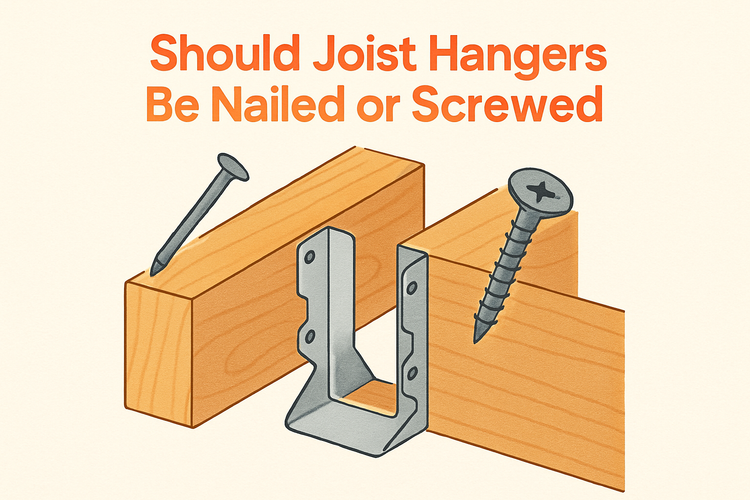Should Joist Hangers Be Nailed Or Screwed

Understanding the Role of Joist Hangers in Timber Construction
Joist hangers are essential for maintaining structural integrity in timber framing and load-bearing applications. They provide support for joists, enabling safe and secure connections between beams and framing members.
Using the appropriate joist hangers is crucial, as incorrect installation methods can compromise the strength and stability of a structure. Choosing between nails and screws as fasteners affects both performance and compliance with building codes.
Fasteners: Nails vs. Screws – What’s the Difference?
Nails and screws may appear similar, but they behave differently under load. Nails are typically preferred in structural applications due to their lateral strength and slight flexibility, which allows them to move slightly under tension without breaking.
Screws, on the other hand, provide exceptional holding power and are less likely to work loose over time. However, their rigidity can be a drawback when exposed to lateral shear or heavy dynamic loads. In timber framing, this can lead to splitting or excessive stress on the materials involved.
Strong connections rely not only on the choice of fastener but also on how it's driven. Nails are often used in joist hangers because they're quicker to install and generally comply with most joist hanger manufacturer guidelines. Screws, unless specifically rated for the application, may not meet these requirements and could even void installation warranties.
For guaranteed performance, always consult the joist hanger manufacturer's recommendations. Many instructional guides and product listings for screws and nails in construction applications clarify the appropriate fastener based on load type and timber species.
Manufacturer Recommendations: Following the Installation Guide
The majority of joist hanger manufacturers stipulate specific types of nails—usually hot-dipped galvanized or stainless steel—for use in structural connections. These fasteners have been tested for compatibility with the hanger's design and material.
Using the wrong fasteners, such as drywall screws or non-galvanized nails, could compromise the bracket’s effectiveness. Structural screws that have been approved for use in timber often carry special ratings, but they are not universally accepted unless specified by the manufacturer.
Companies producing joist hangers often include installation diagrams with fastener placement, size, and nail type. It's essential to follow these directives precisely—not just for safety, but also for insurance and code compliance.
Failure to adhere to the manufacturer’s guidance can lead to inspection failures or long-term structural issues. If you have doubts, refer back to the official documentation or consult with a building professional.
Building Code Compliance and Structural Integrity
In many regions, building codes demand the use of nails in joist hanger installations over screws. This requirement reflects the need for both strength and ductility in timber connections, particularly in seismic or high-load buildings.
Nails offer a tested method for achieving this balance. Their behavior under repeated dynamic loading makes them a reliable choice for structural elements where tension and movement are part of the lifecycle. Screws lacking flexible shanks can be brittle under heavy bending forces, making them vulnerable to snapping in applications where stability is vital.
Inspections often focus on these small yet critical details, and failing to meet code can lead to costly rebuilds or structural reinforcements. Ensuring code-compliant fastener use when working with joist hangers protects occupants and helps futureproof building investments.
Using approved fasteners is just one part of staying compliant. Incorporating certified hardware such as angle brackets and restraint straps can further bolster structural performance in combination with joist hangers.
Making the Right Choice for Long-Term Durability
While nails are generally the go-to choice, there are cases where structural screws are approved, particularly when driving nails could damage the timber or when working in tight spaces. In these cases, only certified structural screws should be used—those explicitly approved for joist hanger installation by both national standards and manufacturers.
Durability also involves rust resistance, especially in outdoor or high-moisture environments. Stainless steel or galvanized steel nails are preferred for prolonged exposure. Using improper fasteners not only jeopardizes the structure, but can also cause premature failure due to corrosion or timber degradation.
In some situations, hybrid installation methods may be used—such as using screws on one side and nails on the other, based on accessibility or design constraints—but only if specified by the manufacturer or a structural engineer. When in doubt, it's always best to default to the guidelines provided by the hardware supplier.
Ultimately, whether you’re installing joist hangers, reinforcing frameworks with angle brackets, or working with load-bearing connectors, attention to fastener specifications is key to maximum safety and performance.
